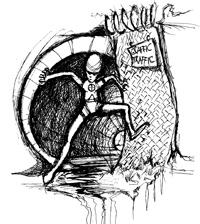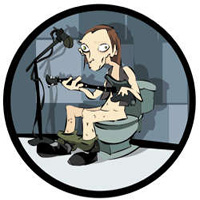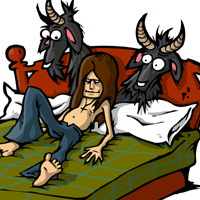 Graffic Traffic
Graffic Traffic
by Ryk McIntyre
illustration by Greg Prindeville
When I was a kid, summers were largely spent with cousins up in Damariscotta, Maine, and that meant ice cream at RoundTop, Roy Wayning’s boat (Biggest and Fastest in the World!), and of course, losing my virgini- uh, I mean comics. Comic Books.
If I was lucky, I could sneak the issues of Eerie, Creepy, or even (joy!) Vampirella past my mother’s sense of mothering. But what I remember really looking forward to were DC’s Justice League of America/Justice Society cross-overs. We’re talking bunches of heroes from “our Earth” as well as “Earth Two.” Sometimes even Earth-Three or Earth-S got to play as well. (It probably doesn’t make a bit of sense to most of you, but DC used “alternate Earths” to explain why there was a Batman and Superman who were old enough to have fought in WWII, as well as our more modern counter-parts, or why Shazam had a friend who was a talking tiger, but never seemed to meet Green Arrow or AquaMan. Heck, we even got two Flash’s, our red-suited speedster as well as the guy with the Mercury helmet. Ahhh, those were the days.) Along with this fistful o’ heroes would be the multiple villains, team-ups, and in the end, Justice always won. At a healthy 52-64 pages, these were books that would last hours at least.
Which is why most modern cross-over team-ups suck.
Three that I picked-up recently were as follows, Culture Clash -Teknophage vs Zeerus (TeknoComics/Paul Jenkins-writer, Fred Harper-art), Ghost/Hellboy (Dark Horse / Mike Mignola-writer, Scott Benefiel and Jasen Rodriguez-art), and finally, Spawn/WildCats (Image/Alan Moore-writer, Scott Clark and Sal Regla-art). All three define comics as thin product. None has any lasting effect on the characters involved (not that the JLA/JSA cross-overs did, but they at least were fun…), and they all left me feeling like they exist only to separate me from a couple dollars and stress-out the I-gotta-have-it completist collectors.
Culture Clash brings together the central villains from Leonard Nimoy’s Primortals and TeknoPhage and, what could have gone in any direction with two powerful, Macheavellian characters, becomes a dumb slug-fest on a planet that slowly devolves the protaganists, a planet conveniently located in a nether-dimension between their respective home worlds (i.e., won’t have an effect on the characters’ universes later) and to top it all off, the writing isn’t that bad, given the limited premise. Certainly Paul Jenkins is a good writer, so forgive him this silliness, maybe his kids needed new shoes.
Alan Moore is perhaps the originator of the silk-purse comic from a sow’s ear concept, but with Spawn/WildCats, as with most of his output for Image, it seems like… well, so what? Do I care more about Maul and Grifter and Voodoo than I did before? Not really, no. Does it deepen and enrich the Spawn mythology to hint he might become a future evil despot? Maybe, but Peter David did it better with his two-part Future Imperfect Hulk story, and it made more sense for the character in question. So, apart from some good lines and funny jokes (especially the appearance of the Phlebian Brothers in issue #2), I found it predictable and not worth the $10 you’d pay for the four issues. You’d think that Alan Moore had made enough money already working with “characters that are interesting to me because they’re such blank slates,” that he could go back to From Hell or even… maybe… Big Numbers? I’m a dreamer…
Last off, Ghost/Hellboy unites two of the Legend imprint’s most notable figures. Or at least, it tries to. Granted, Spawn/WildCats started off with the “let’s-fight-until-we-try-talking” way of two or more heroes meeting, but this story smacks of rote from half-way through issue #1 to the “Oh-gosh-the-Nasty-Mask-guy-was Lying! Hellboy isn’t evil! He is!!!!” shocker in issue #2.
So do I hate everything this month? No, no. There’s good stuff out there, or, to quote The Kids In The Hall, “Fine Ham Abounds!!!”
Let me say how well Kingdom Come (DC/Mark Waid-writer, Alex Ross-painter to the Gods) #2 builds on the foundation of #1. Mark Waid is only now getting his proper notice, even after years of making The Flash readable. And Alex Ross… hell, don’t listen to me, just look at his art. Look at it again. Especially fun is the bar scene on pages 26-29. See if you can spot the following: Lobo looking old, Baron Bedlam, Solomon Grundy, DeadMan, the Creeper, some guy wearing the mask from the cover of a Steve Miller album, Eclipso, Jack Frost making icecubes, Brother Power the Geek, Rorschach, the Human Bomb, Plastic Man, Weather Wizard, those two kids from the SuperFriends, Steed and Emma Peel of the Avengers, the Village People, and there’s more. It’s like a dark, drunken Where’s Waldo?
A few quick picks worth their price: Flex Mentallo (DC/Grant Morrison-writer, Frank Quitely-art), where the metaphorical plea for pre-gritty, innocent superheroes continues, or another of Grant’s projects; Aztec,The Ultimate Man (co-written with mark Millar, art by N. Steven Harris and Keith Champagne), a fairly straight-ahead superbook, but nonetheless very entertaining. Check out The Piper‘s little pipe robots. And for exquisite silliness with no angst but lots of monkeys, please check out Kid Blastoff (AmazeInk-Slave labor/ Evan Dorkin & Sarah Dyer-the whole comic). Reprinted from Disney Adventures, this is just plain fun, mostly wholesome, but some things do sort of slip through. Or to quote Kid Blastoff (though it may also be one of the monkeys), “Whoa! Giganto Space Mines!”



